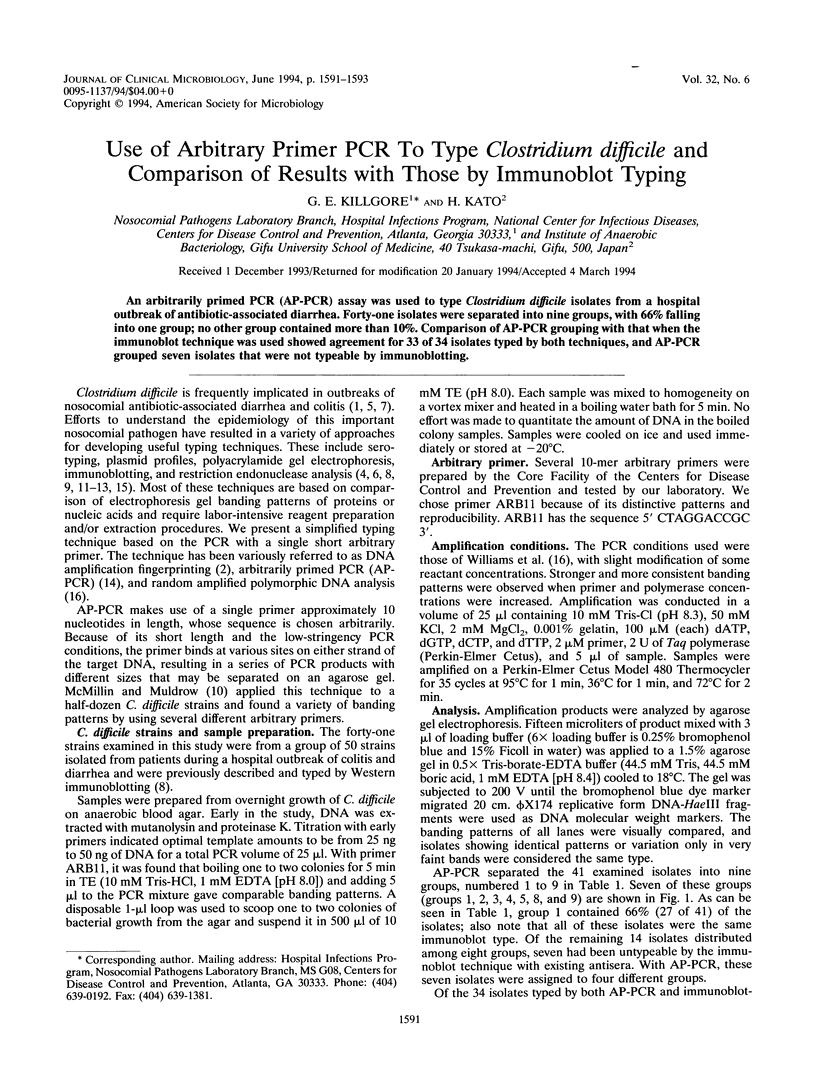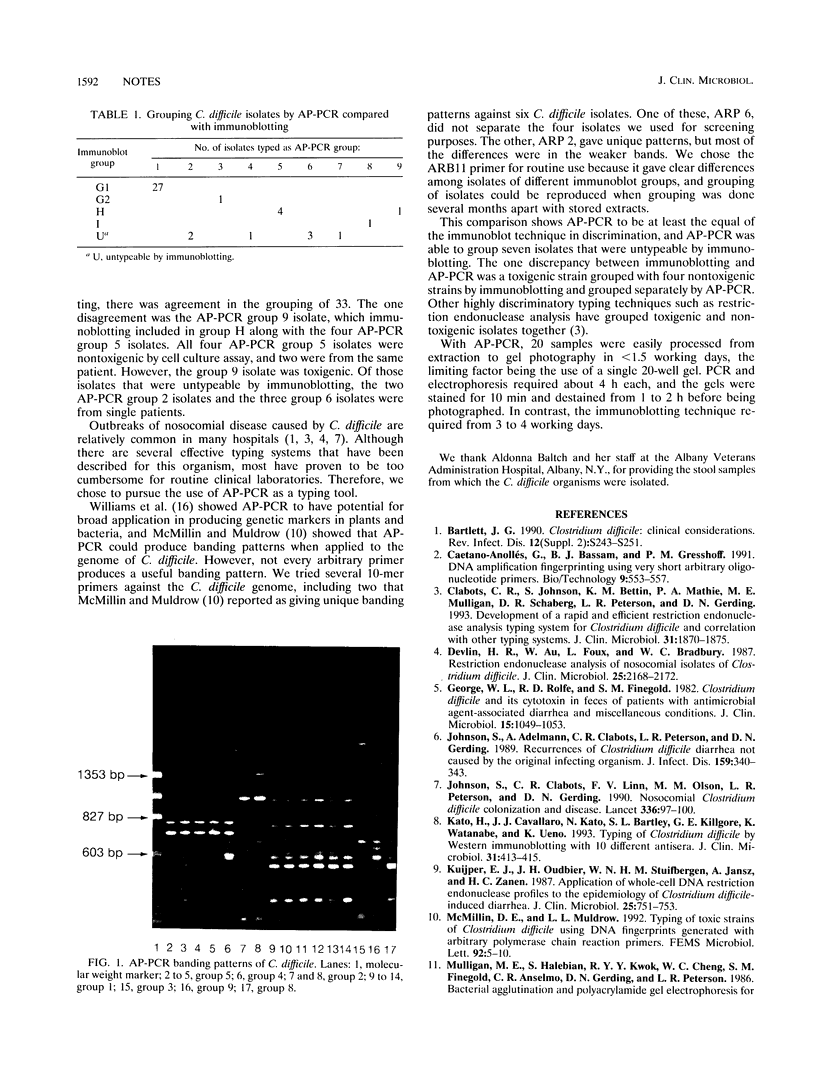Abstract
An arbitrarily primed PCR (AP-PCR) assay was used to type Clostridium difficile isolates from a hospital outbreak of antibiotic-associated diarrhea. Forty-one isolates were separated into nine groups, with 66% falling into one group; no other group contained more than 10%. Comparison of AP-PCR grouping with that when the immunoblot technique was used showed agreement for 33 of 34 isolates typed by both techniques, and AP-PCR grouped seven isolates that were not typeable by immunoblotting.
Full text
PDF


Images in this article
Selected References
These references are in PubMed. This may not be the complete list of references from this article.
- Bartlett J. G. Clostridium difficile: clinical considerations. Rev Infect Dis. 1990 Jan-Feb;12 (Suppl 2):S243–S251. doi: 10.1093/clinids/12.supplement_2.s243. [DOI] [PubMed] [Google Scholar]
- Caetano-Anollés G., Bassam B. J., Gresshoff P. M. DNA amplification fingerprinting using very short arbitrary oligonucleotide primers. Biotechnology (N Y) 1991 Jun;9(6):553–557. doi: 10.1038/nbt0691-553. [DOI] [PubMed] [Google Scholar]
- Clabots C. R., Johnson S., Bettin K. M., Mathie P. A., Mulligan M. E., Schaberg D. R., Peterson L. R., Gerding D. N. Development of a rapid and efficient restriction endonuclease analysis typing system for Clostridium difficile and correlation with other typing systems. J Clin Microbiol. 1993 Jul;31(7):1870–1875. doi: 10.1128/jcm.31.7.1870-1875.1993. [DOI] [PMC free article] [PubMed] [Google Scholar]
- Devlin H. R., Au W., Foux L., Bradbury W. C. Restriction endonuclease analysis of nosocomial isolates of Clostridium difficile. J Clin Microbiol. 1987 Nov;25(11):2168–2172. doi: 10.1128/jcm.25.11.2168-2172.1987. [DOI] [PMC free article] [PubMed] [Google Scholar]
- George W. L., Rolfe R. D., Finegold S. M. Clostridium difficile and its cytotoxin in feces of patients with antimicrobial agent-associated diarrhea and miscellaneous conditions. J Clin Microbiol. 1982 Jun;15(6):1049–1053. doi: 10.1128/jcm.15.6.1049-1053.1982. [DOI] [PMC free article] [PubMed] [Google Scholar]
- Johnson S., Adelmann A., Clabots C. R., Peterson L. R., Gerding D. N. Recurrences of Clostridium difficile diarrhea not caused by the original infecting organism. J Infect Dis. 1989 Feb;159(2):340–343. doi: 10.1093/infdis/159.2.340. [DOI] [PubMed] [Google Scholar]
- Johnson S., Clabots C. R., Linn F. V., Olson M. M., Peterson L. R., Gerding D. N. Nosocomial Clostridium difficile colonisation and disease. Lancet. 1990 Jul 14;336(8707):97–100. doi: 10.1016/0140-6736(90)91605-a. [DOI] [PubMed] [Google Scholar]
- Kato H., Cavallaro J. J., Kato N., Bartley S. L., Killgore G. E., Watanabe K., Ueno K. Typing of Clostridium difficile by western immunoblotting with 10 different antisera. J Clin Microbiol. 1993 Feb;31(2):413–415. doi: 10.1128/jcm.31.2.413-415.1993. [DOI] [PMC free article] [PubMed] [Google Scholar]
- Kuijper E. J., Oudbier J. H., Stuifbergen W. N., Jansz A., Zanen H. C. Application of whole-cell DNA restriction endonuclease profiles to the epidemiology of Clostridium difficile-induced diarrhea. J Clin Microbiol. 1987 Apr;25(4):751–753. doi: 10.1128/jcm.25.4.751-753.1987. [DOI] [PMC free article] [PubMed] [Google Scholar]
- Mulligan M. E., Halebian S., Kwok R. Y., Cheng W. C., Finegold S. M., Anselmo C. R., Gerding D. N., Peterson L. R. Bacterial agglutination and polyacrylamide gel electrophoresis for typing Clostridium difficile. J Infect Dis. 1986 Feb;153(2):267–271. doi: 10.1093/infdis/153.2.267. [DOI] [PubMed] [Google Scholar]
- Mulligan M. E., Peterson L. R., Kwok R. Y., Clabots C. R., Gerding D. N. Immunoblots and plasmid fingerprints compared with serotyping and polyacrylamide gel electrophoresis for typing Clostridium difficile. J Clin Microbiol. 1988 Jan;26(1):41–46. doi: 10.1128/jcm.26.1.41-46.1988. [DOI] [PMC free article] [PubMed] [Google Scholar]
- Peerbooms P. G., Kuijt P., Maclaren D. M. Application of chromosomal restriction endonuclease digest analysis for use as typing method for Clostridium difficile. J Clin Pathol. 1987 Jul;40(7):771–776. doi: 10.1136/jcp.40.7.771. [DOI] [PMC free article] [PubMed] [Google Scholar]
- Welsh J., McClelland M. Fingerprinting genomes using PCR with arbitrary primers. Nucleic Acids Res. 1990 Dec 25;18(24):7213–7218. doi: 10.1093/nar/18.24.7213. [DOI] [PMC free article] [PubMed] [Google Scholar]
- Wexler H., Mulligan M. E., Finegold S. M. Polyacrylamide gel electrophoresis patterns produced by Clostridium difficile. Rev Infect Dis. 1984 Mar-Apr;6 (Suppl 1):S229–S234. doi: 10.1093/clinids/6.supplement_1.s229. [DOI] [PubMed] [Google Scholar]
- Williams J. G., Kubelik A. R., Livak K. J., Rafalski J. A., Tingey S. V. DNA polymorphisms amplified by arbitrary primers are useful as genetic markers. Nucleic Acids Res. 1990 Nov 25;18(22):6531–6535. doi: 10.1093/nar/18.22.6531. [DOI] [PMC free article] [PubMed] [Google Scholar]



